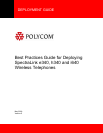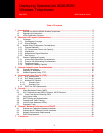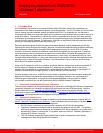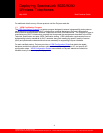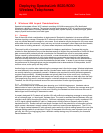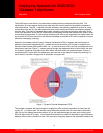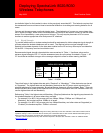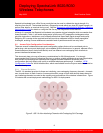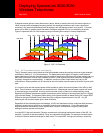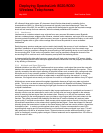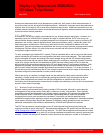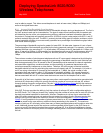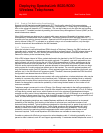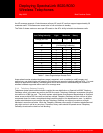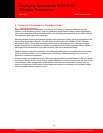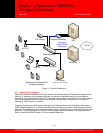
Deploying SpectraLink 8020/8030
Wireless Telephones
May 2009 Best Practices Guide
7
©2009 Polycom, Inc. All rights reserved.
Polycom and the Polycom logo are registered trademarks of Polycom, Inc. All other trademarks are the property of Polycom, Inc. or their respective companies.
2.4GHz 802.11b/802.11g (CCK)
Rate
(Mb/s)
1 2 5.5 11
Best
Practice
s (dBm)
-75 -70 -69 -65
ten decibels higher for the handset to return to the previously associated AP. This behavior requires that
the assessment area must have at least a ten decibel difference to enable good roaming behavior for all
cases.
Corners and doorways pose a particular design issue. The shadowing of corners can cause steep drop-
offs in signal coverage. Make sure to have adequate cell overlap at and around corners so that the audio
stream is not impacted by a user going around corners. This may require placement of AP at corner
locations to ensure appropriate cover and prevent RF shadows.
2.1.2 Signal Strength
To provide reliable service, wireless networks should be engineered to deliver adequate signal strength in
all areas where the wireless telephones will be used. The required minimum signal strength for all
SpectraLink handsets depends on the data rates enabled on the AP and may also require consideration
for the 802.11 frequency band and modulation used.
Recommended signal strength characteristics are summarized in Table 1. Use these values as the
entrance signal strength of AP “A” into the assessment area for cell overlap, illustrated in Figure 1. AP
“B” should be ten decibels stronger at the coverage midpoint to allow for clean roaming handoffs.
Table 1 – 2.4GHz
The critical factor is the highest data rate set to “Required” or “Mandatory”
1
. Other data rates can be set
to “Supported”. The highest data rate set Mandatory determines the RF power output required by th
wireless telephone for proper operation. Broadcast frames (beacons) utilize the lowest “Basic”
e
2
data rate
while multicast frames (used for the SpectraLink i640’s push-to-talk feature and SRP handset check-ins)
use the highest data rate set Mandatory.
Referencing Table 1 the highest rate set Mandatory (Required) determines the signaling requirements for
the wireless telephone in all areas where they are used.
For example, if an 802.11b/g access point has 1Mbps, 2Mbps, 5.5Mbps and 11Mbps all set
Mandatory, the handset requires -65dBm in all areas.
For example, if an 802.11b/g access point has 1Mbps Mandatory and other rates set Supported (or
“Enabled”) the handset requires -75dBm in all areas.
1
Access Point (AP) vendors refer to this configuration setting differently but the value indicates a data rate that clients must be
capable of utilizing in order to associate with the access point. These data rates are also used for different data traffic types by
clients and APs that should be considered when designing for coverage requirements.
2
The 802.11-2007 Standard defines any data rate set as required to be basic rates. See 802.11-2007 for additional details.
(http://www.ieee.org
)



